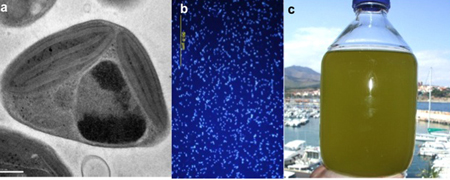A tiny green alga with minimal cell structure found at the top of the water column where plants live, Ostreococcus tauri is one of the picoeukaryotes that make up a fraction of the oceanic biomass but are significant contributors to global photosynthetic activity. A key part of the base of the ocean food web, Ostreococcus has the smallest known nuclear genome of all known free-living eukaryotes, and is a model species for studying the population genomics of marine photopicoplankton.
In 2006, the DOE JGI sequenced a strain of O. tauri found further down the water column and adapted to low-light, to understand how the species has adapted to its particular ecosystem. The information allowed researchers to compare the data collected with those from other Ostreococcus strains: those found in “high light” and those that were “surface-isolated.” So far four groups of Ostreococcus, each with a single ancestor and adapted to ecologically different niches, have been identified. Researchers now want to learn more about the natural variation within a single species, specifically O. tauri, by studying several strains collected from a number of locations in the Mediterranean. The information is expected to provide information on several basic evolutionary and ecological topics.

Photo:by Moreau lab, CNRS
a. TEM picture of Ostreococcus tauri
(ML Escande, Oceanological Observatory of Banyuls, France);
b. DAPI staining of O. tauri cells;
c. 2 Liter culture of O. tauri isolated from the bay of Banyuls seen in the background.
Principal Investigators: Hervé Moreau, CNRS, France
Program: CSP 2010